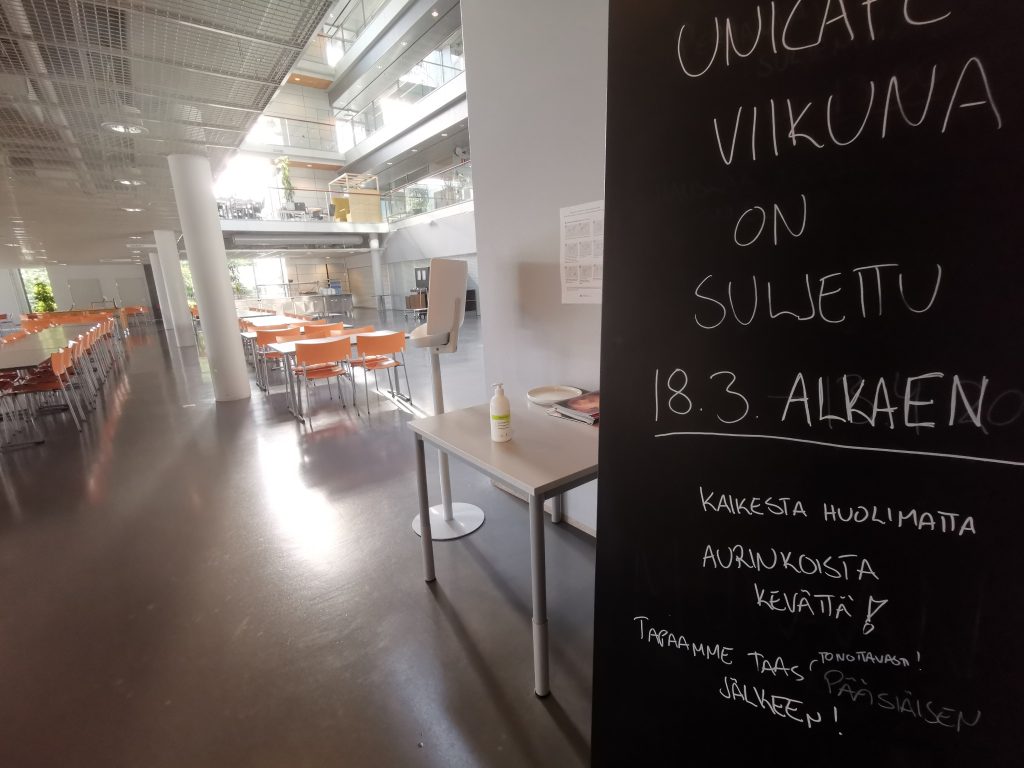The starting shot for the telecommuting year of 2020 (Photo by Mikael Niku)
Professor Tomi Taira served as director of department. The department’s operations are carried out at two campuses, with the disciplines of anatomy, physiology, biochemistry and pathology at Viikki and the disciplines of genetics and microbiology at Meilahti.
Anatomy and developmental biology
Professor Antti Iivanainen, head of discipline, and University Lecturer Mikael Niku continued their research on the early development of intestinal microbiota and the immune system. A report on their efforts was published in the Scientific Reports journal. This research is part of the doctoral education of doctoral student Aleksi Husso. Productive cooperation with the animal science unit in Viikki, the Jokioinen research centre of Natural Resources Institute Finland, the Faculty’s own swine researchers as well as the University of Tartu and Ghent University continued, while new cooperation was initiated with Justus Reunanen from the University of Oulu and Kati Hanhineva from the University of Turku. These projects received research funding from the Finnish Cultural Foundation and foundations specialised in veterinary medicine. Research cooperation focusing on canine bone diseases continued with Hannes Lohi’s research group. Lea Mikkola, DSc (Agriculture and Forestry), defended her doctoral thesis on canine hip dysplasia on 18 June and took up a role as a postdoctoral researcher at the Single Cell Omics unit operating under BioCity Turku.
As part of the HiLIFE research organisation, University Lecturers Tiina Pessa-Morikawa and Mikael Niku maintained flow cytometry and laser microdissection activities, the core services for research coordinated by the Faculty.
In the research projects focused on macroscopic anatomy headed by University Lecturer Juha Laakkonen, licentiate students made a significant contribution with their theses. Laakkonen has continued his pedagogical investigations by looking into using drawing to support the study of anatomy.
At short notice, virtual learning materials were designed and practices created for macroscopic anatomy teaching, which helped provide online instruction during the pandemic-related restrictions. Unfortunately, not all learning outcomes were achieved in the exceptional circumstances. In the future, the video and image material produced can also be used to support and supplement teaching in normal circumstances. Thanks to virtual microscopy, it was possible to provide teaching in microscopic anatomy almost as usual. In addition, the development of a virtual microscopy platform to be shared by most Finnish medical faculties was initiated in 2020.
Mikael Niku served as a member of the Faculty Council and the steering group for the digitalisation of teaching at the University of Helsinki. Antti Iivanainen served as the director of the Bachelor’s Programme in Veterinary Medicine, a member of the committee for research and research-oriented postgraduate education, the Faculty’s representative in entrance examination efforts as well as a member of the steering group of the MD PhD Programme.
Senior Laboratory Technician Santeri Suokas was responsible for the operations of the histology laboratory and contributed to the maintenance of the laser microdissection service. As in the previous year, Senior Laboratory Technician Kirsi Lahti was responsible for the discipline’s research laboratory.
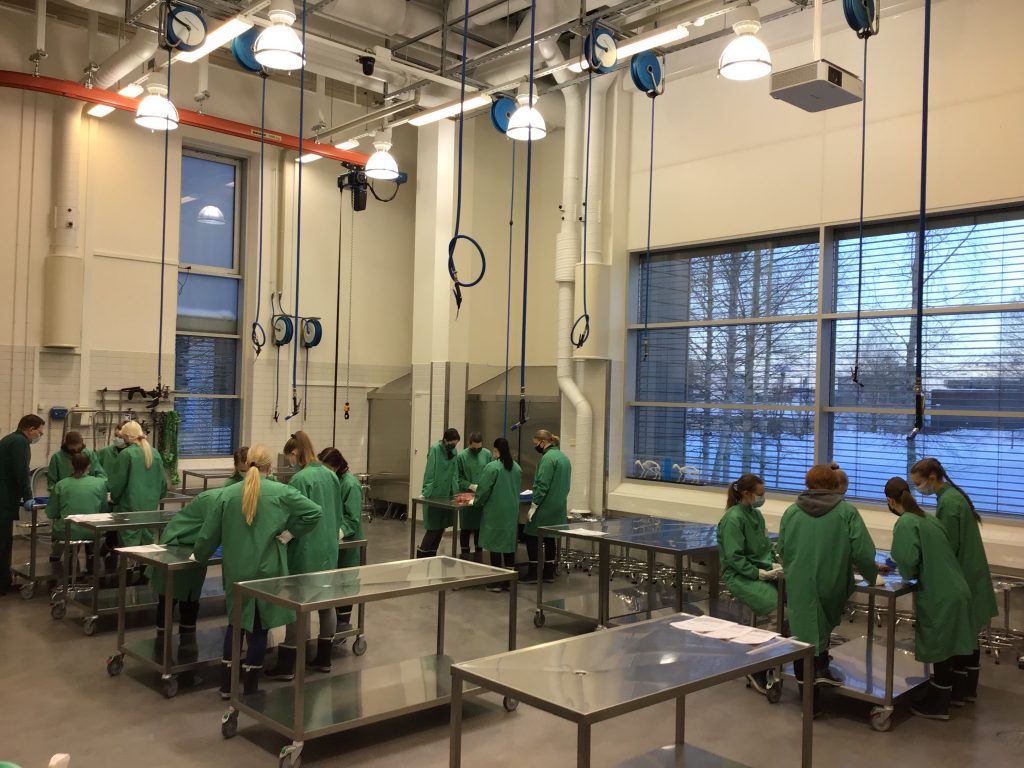
While students are enjoying contact instruction, other work continues to be done remotely… (Photos by Mikael Niku)
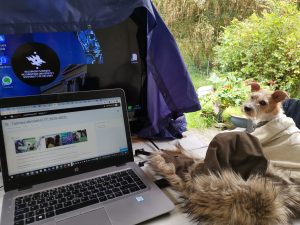

Biochemistry, cell biology and genetics
Genetics
In addition to the challenges brought about by the pandemic, the past year was marked by the sadness of letting go and the joy of success. Kati Dillard, LVM, who had been working on her doctoral thesis in Professor Hannes Lohi’s group, suddenly passed away after a short illness. Kati was a well-liked doctoral student in her research group who will be fondly remembered. The discipline headed by Professor Lohi continued its active operations particularly in the form of international collaboration, which produced some 30 articles that were either published or submitted for publication. They encompass a diverse range of clinical, genetic and metabolic findings on cats and dogs, as well as findings related to behavioural epidemiology. The genetic findings pertained to a range of disease groups, including pulmonary, eye, bone and muscle diseases as well as canine fearfulness. A study on unwanted behaviour in dogs gained considerable international attention in key media outlets, and a related media release was the second-most read text published by the University of Helsinki as a whole in 2020.
A total of five doctoral students completed their doctoral thesis under the supervision of the group: Maria Kaukonen (eye diseases), Riika Sarviaho (epilepsy and genetics of anxiety disorders), Lea Mikkola (genetics of hip dysplasia, jointly supervised by Professor Iivanainen), Meharji Arumilli (genomics and bioinformatics) and Milla Salonen (canine and feline behaviour). Three of these theses were approved with distinction (Kaukonen, Mikkola, Salonen). Three of the doctoral theses were completed at the Faculty of Medicine. Senior Researcher Marjo Hytönen, PhD, from Professor Lohi’s group was granted the title of docent in molecular genetics at the Faculty of Medicine.
The discipline was prominently featured in key Finnish media outlets in connection with reporting on dog breeding and related ethical issues (e.g., Yle, MTV, Helsingin Sanomat). In 2020 the Annual Veterinary Congress was held online, with genetics and gene research as a central theme for one whole day under the science section. This part of the programme was coordinated by Professor Lohi together with his students Maria Kaukonen, DVM, and Docent Marjo Hytönen. The discipline acquired new funding from, among others, the Agria research fund, the Cancer Foundation and the Finnish Foundation for Cardiovascular Research. The discipline continues its research efforts in epidemiology, genetics, genomics, transcriptomics and metabolomics, with significant breakthroughs expected in 2021.
Biochemistry and cell biology
In late 2019, Professor Jyrki Kukkonen, the discipline supervisor, took up the professorship in pharmacology at the Faculty of Medicine, after which University Lecturer Marjo Salminen took over responsibility for the teaching in the discipline. In addition, teaching was supported by recruiting Kaisa Rajakylä to the Faculty as an hourly paid teacher. She investigates the role of the cell’s cytoskeleton in canine mammary tumours. Marjo Salminen continued her research in cooperation with Juha Partanen (Faculty of Biological and Environmental Sciences, University of Helsinki) on brain development, focusing especially on the diversity of individual cells of mesencephalon and metencephalon nuclei by using RNA profiling, supported by funding from the Sigrid Jusélius Foundation. The nuclei contain a variety of neurons which primarily utilise gamma-aminobutyric acid or glutamate as neurotransmitters, regulating, among other things, animal behaviour, mood and memory. The differentiation and development of the diversity of these neurons is not well known, and neither are the factors regulating this diversity. The goal of this project is to identify the genes that the neurons in these nuclei express, and the ways in which their diversity is guided by genes. An extensive article on the research was published in 2020 in the high-quality Cell Reports journal.
Physiology
The research group headed by Professor Tomi Taira, the discipline supervisor, continued its research on the developmental physiology of the brain, focusing particularly on the role of kainate-type glutamate receptors in the regulation of developmental brain plasticity. Most of the group’s funding is provided by the Academy of Finland, the Sigrid Jusélius Foundation and the Neuroscience Center. Two new postdoctoral researchers began working in the group in 2020: Patricia Seja and Tatjana Kuznetsova.
Among the most interesting research findings of 2020 is an observation according to which stress experienced in early development affects the kainate receptor function of the amygdala and what is known as sensitivity of the neural network in fully grown animals. Abnormal behaviour in animals is another associated phenomenon. This finding can potentially shed light on mechanisms through which events in this early developmental stage become predisposing factors for anxiety and depressive disorders in adulthood. In addition to animal models, the group uses neurons and organoids differentiated from human-induced pluripotent stem cells (hiPSC) in the study of diseases of the central nervous system in cooperation with Professor Timo Otonkoski and Professor Henna Tyynismaa. The travel restrictions brought about by the Covid-19 pandemic hindered a collaborative project focused on the functional comparison of the human and the rodent brain, funded by the Academy of Finland and conducted with the University of Szeged (Hungary). Cooperation has also continued with Aalto University, specifically pertaining to the use of nanofibre materials in the diagnostics and treatment of brain diseases.
Research reports were published in the Frontiers in Cell Neuroscience, Neurobiology of Disease and iScience journals.
University Lecturer Tiina Kukko-Lukjanov and Senior Laboratory Technician Kirsi Kolehmainen have jointly been responsible for the electrophysiological study of organotypic brain slices and cell cultures, as well as the maintenance of related laboratory infrastructures. They have also been responsible for coordinating coursework related to teaching.
Professor Taira has also served as a steering group member in the Doctoral Programme in Clinical Veterinary Medicine. In addition, he serves as the Faculty’s representative (in biology) in the national entrance examination committee.
Microbiology and epidemiology
Professor Olli Vapalahti served as supervisor for the discipline.
The groups headed by Professor of Zoonotic Virology Olli Vapalahti and Associate Professor of Emerging Infectious Diseases Tarja Sironen investigate new and emerging infections, particularly viral infections transmitted by rodents and bats, as well as arboviruses, or viruses transmitted by arthropods (mosquitoes, ticks).
In 2020 the groups focused on projects associated with SARS-CoV-2. Other projects were largely suspended for the year, and planned laboratory visits and other meetings were cancelled. Vapalahti and Sironen participated in national working groups focused on managing the coronavirus pandemic as well as related research and diagnostics, continually cooperating with a range of authorities. In addition, both contributed to coronavirus-related communication and appeared frequently in the media as Finland’s leading coronavirus experts.
In the laboratories of Building EE, all members of the groups took part in the joint coronavirus-related efforts. Sample processing facilities for BSL-2 work were quickly prepared for use, as well as protocols and practical instructions for diagnostic RT-PCR testing targeted at the novel coronavirus, which was utilised in research projects. In the laboratory for BSL-3 work, microneutralisation assays for samples collected from study subjects were established as a continuously working production line, used to measure neutralising antibodies, for example, to determine the duration of immunity and for potential plasma donation therapies. The BSL-3 laboratory was in constant use for studies on live SARS-CoV-2 viruses concerning the inactivation and structure of the virus as well as its interaction with the host cell. In late 2020 the development of a coronavirus vaccine for animals was initiated, preparing the BSL-3 laboratory for animal testing in conjunction with vaccine and drug research.
In 2020 the groups contributed to teaching in veterinary virology, for which Professor Vapalahti serves as the coordinating teacher. In addition to Vapalahti, Tarja Sironen and Eili Huhtamo provided lecture-based instruction. In place of the traditional laboratory course in virology, all teaching took place online, with contributions to remote instruction from Lauri Kareinen, Essi Korhonen and Marianne Kaila as well.
In 2020 Vapalahti’s and Sironen’s groups published a total of roughly 50 peer-reviewed articles, including a finding pertaining to another receptor of SARS-CoV-2 (Cantuti-Castelvetri et al., Science, 2020), the range expansion of the Bombali ebolavirus in Kenya (Kareinen, 2020 EID), the mosquito species occurring in Finland and the viruses they carry (Culverwell CL, 2020; Korhonen EM, 2020; Suvanto MT, 2020) and the prevalence of the tick-borne encephalitis virus in Finland (Uusitalo RJ, 2020). Furthermore, researchers in the groups developed a bioinformatics-based technique (Lazypipe) for identifying and describing both known and new viruses on the basis of sequencing data originating in sample material (Plyusnin I, 2020).
The Versatile Emerging Infectious Diseases Observatory (VEO) project under the EU’s Horizon programme launched in the beginning of 2020, with key European laboratories investigating emerging zoonotic viruses participating alongside Professor Vapalahti’s group. Initially, the project will focus heavily on coronavirus research. The Vector-borne Diseases and Climate Change in Finland: Mapping, Modelling, Mitigation (VECLIMIT) project under the Academy of Finland’s Climate Change and Health (CLIHE) programme also started in 2020. VECLIMIT investigates vector-borne diseases and climate change in Finland. In connection with these projects, ticks and mosquito material were collected in the summer season of 2020 in the Helsinki Metropolitan Area. In mosquito–virus projects directed by Docent Eili Huhtamo, systematic mosquito sample collection was carried out in Helsinki and Eastern Finland under the supervision of Postdoctoral Researcher Essi Korhonen, in addition to which mosquitoes were also collected in the Ostrobothnia region. Cooperation related to the study of mosquito-borne viruses was initiated with the University of Eastern Finland as well as the Korkeasaari Zoo and its wildlife hospital. In the study of bird specimens, the special expertise of the Faculty’s researchers specialised in physiology and pathology was utilised. In December Yegor Korzyukov defended his doctoral thesis at the Faculty of Veterinary Medicine on novel arena viruses that cause the boid inclusion body disease (BIBD) in snakes – several viruses can be found simultaneously in individual snakes – and snakes’ immune response against the viruses (approved in 2021). The thesis was supervised by Jussi Hepojoki and Olli Vapalahti.
In 2020 the research groups obtained a substantial amount of new research funding, especially for coronavirus-related research, from, among others, the Jane and Aatos Erkko Foundation, the Academy of Finland and the Sigrid Jusélius Foundation, as well as from donations. In addition, the Maj and Tor Nessling Foundation awarded a three-year project grant to Essi Korhonen for her projects focused on Kenya. Associate Professor Sironen’s research group received funding from the Jane and Aatos Erkko Foundation and Business Finland.
University Lecturers Joanna Koort, Silja Åvall-Jääskeläinen and Anna-Maija Virtala as well as doctoral student Kristiina Suominen, LVM, work in the unit’s research project on the epidemiology and molecular epidemiology of the Capnocytophaga spp bacterium, with the Finnish Institute for Health and Welfare as a partner. However, the project has been largely suspended due to the coronavirus situation.
Virtala, Koort and Åvall-Jääskeläinen headed a thesis workshop, through which they contributed to supervising several licentiate theses. The internet-based learning game for identifying bacteria previously developed in the discipline was revamped in autumn 2020, as Koort and Åvall-Jääskeläinen utilised, as clients, the services of the Faculty of Science’s software engineering lab. The students participating in the project recoded the game into an entirely new form, adding several new features in the process.
In November, Pia Vennerström defended her doctoral thesis at the Faculty of Veterinary Medicine on the virus that causes viral haemorrhagic septicaemia in rainbow trout in Finnish fish farms after investigating the effects of four surveillance programmes on diagnosing the disease and the options for eradicating it. Her thesis was supervised by Anna-Maija Virtala and Olli Vapalahti. A programme based on syndromic surveillance, where the fish farmers had samples analysed whenever they observed symptoms of the disease in their fish, was found to be the best option.
Virtala has also been part of a Teachers’ Academy project related to the assessment of interdisciplinary theses, the Developing Assessment Practices in Higher Education (DAPHNE) project of the University of Helsinki and, among others, a project on zoonoses among veterinarians, all of which have drafted and published several scholarly articles. Virtala has contributed to teaching doctoral students in a seminar series on the methodology of biostatistics and epidemiology as well as on several individual courses organised by doctoral schools, in addition to which she has represented Viikki Campus on the board of the Teachers’ Academy, served in the bachelor’s programme steering group, the teaching skills committee and as the coordinator of the specialist training in infectious animal diseases for veterinarians.
University Lecturer Sami Junnikkala’s research on pig immunology and welfare continued through collaboration with the swine specialists of the Saari unit in connection with research conducted by doctoral student Virpi Sali. Cooperation with Heli Simojoki was initiated in conjunction with her Terve vasikka (‘Healthy calf’) project funded by the Finnish Development Fund of Agriculture and Forestry (Makera). In 2020 the course in veterinary immunology was organised online. In addition to course coordinator Junnikkala, lectures were given by Marianne Kaila and, in the role of student-teacher, Meri-Tuuli Hartikainen. Silja Åvall-Jääskeläinen was one of the two teachers of the remote laboratory work component. In his role as the discipline’s supervising teacher, Junnikkala has, among other things, contributed to measures relating to the wellbeing and supervision of the Faculty’s students as the course coordinator of the expanded Professional Growth of a Veterinarian course.
Professor Emerita Liisa Sihvonen continued to contribute to teaching, and her research projects focusing on animal disease viruses continue. As in previous years, Senior Laboratory Technician Anja Osola and Laboratory Engineer Esa Pohjolainen were responsible for the discipline’s research laboratory.
Pathology and parasitology
The discipline was headed by Professor Antti Sukura.
Much like everywhere else in the world, the discipline’s year was marked by the dominance of the Covid-19 pandemic. In March, as the virus started to spread in Finland, the entire University of Helsinki transferred to remote teaching, with teachers in pathology also adapting, over the course of a single weekend, to organising teaching and exercises for second-year students online. Professional growth into veterinarians is not only about acquiring theoretical knowledge, but also about developing skills and applying knowledge in practice. Consequently, the system of rotation for clinical pathology instruction and the opening course of the autumn were implemented on site even in the exceptional circumstances, in compliance with the relevant safety regulations. Moreover, some research and most diagnostic work cannot be conducted online. As a result, the staff of the histology laboratory and autopsy room, as well as most of the veterinary pathologists and researchers carried out some of their work in Faculty facilities.
One of the highlights of the extraordinary year was in November when Clinical Instructor Pernilla Syrjä, DVM, Dipl ECVP, defended her doctoral thesis in veterinary medicine in the field of neuropathology entitled ‘Vacuolar Storage Disease in Lagotto Romagnolo Dogs – Pathology, autophagy and extracellular vesicles’. The public examination of the thesis was held online, with the opponent Frauke Seehusen, DVM, PhD, Dipl ECVP, attending from Zurich. The technical arrangements worked well and both the opponent and the doctoral candidate offered the audience – some of whom were present on site, others online – an enjoyable academic event.

In the remotely held public examination, opponent Frauke Seehusen was in Zurich, while doctoral candidate Pernilla Syrjä and custos Antti Sukura attended from Helsinki, communicating via the internet over a video link. In November, it was still possible for a limited audience to attend public examinations on site. (Photo by Satu Leppänen)
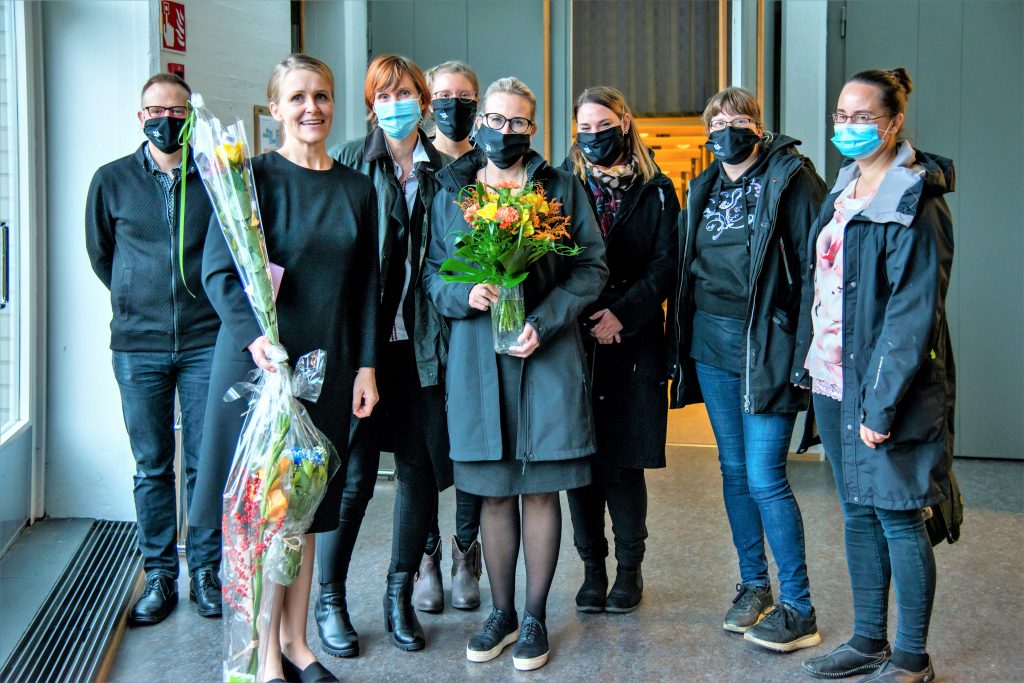
The pathology staff presenting flowers to the recent doctoral graduate. (Photo by Satu Leppänen)
The annual meeting and symposium of Nordic veterinary pathologists, the organising of which was the responsibility of the discipline in 2020, was upended by the pandemic. University Lecturer Heli Nordgren, DVM, who serves as the president of the Nordic Society for Veterinary Pathology, had to face the fact that the collaboratively planned event had to be cancelled and rescheduled as an online event to be held in 2021. Remote meetings can help in continuing international activities, but they make it difficult to have the kind of personal interaction that traditional conferences offer.
LYKKY, a project headed by Heli Nordgren and funded by the Development Fund for Agriculture and Forestry (Makera), got off to a good start in 2020, and currently data is being collected on the basis of the initial results on the causes of death among Finnish dairy cows. Veterinary specialist in infectious diseases Karoliina Hagner, LVM, the discipline’s long-serving university instructor, is conducting doctoral research in the project.
In spite of being on family leave, University Lecturer Kristel Kegler, DVM, PhD, Dipl ECVP, was able to complete the esteemed international degree in veterinary pathology offered by the European College of Veterinary Pathologists (Dipl ECVP).
University Lecturer Niina Airas, DVM, continued the KORAT feline study and made a considerable contribution to the successful implementation of the discipline’s diagnostic and educational efforts in 2020. Alongside teaching in the discipline, Niina developed education on the Faculty level by serving in the steering group of the Bachelor’s Programme in Veterinary Medicine.
As in previous years, pathological diagnostics was a busy line of work: teaching autopsies included, the discipline carried out a total of 573 animal autopsies, in addition to which tissue samples collected from 831 live patients and 373 exfoliative cytology specimens were analysed. In contemporary high-quality clinical work, veterinary pathologists are specialists essential to patient diagnostics. Veterinarians Hanna-Maaria Javela, LVM, and Minna Söderström, LVM, are completing specialist training in the discipline in infectious animal diseases, actively participating in diagnostic work as well as student supervision, guidance and teaching together with veterinarian Sanna Malkamäki, LVM. The work of Satu Leppänen and Ariel Bonachea, the senior laboratory technicians in the autopsy room, in preparing the animals to be autopsied and the specimens to be processed, is of utmost importance to teaching, diagnostics and research. In the histology laboratory, the skills of Bioanalyst Kati Holmsten and Laboratory Technicians Laura Vähälä and Taneli Lohilahti in processing tissue samples and in special staining makes it possible to conduct diagnostics and process the samples of a number of research groups. Towards the end of the year, Taneli left to take up a new challenge outside the Faculty, and the histology team welcomed Anne Kujanpää, MSc, as a new member.
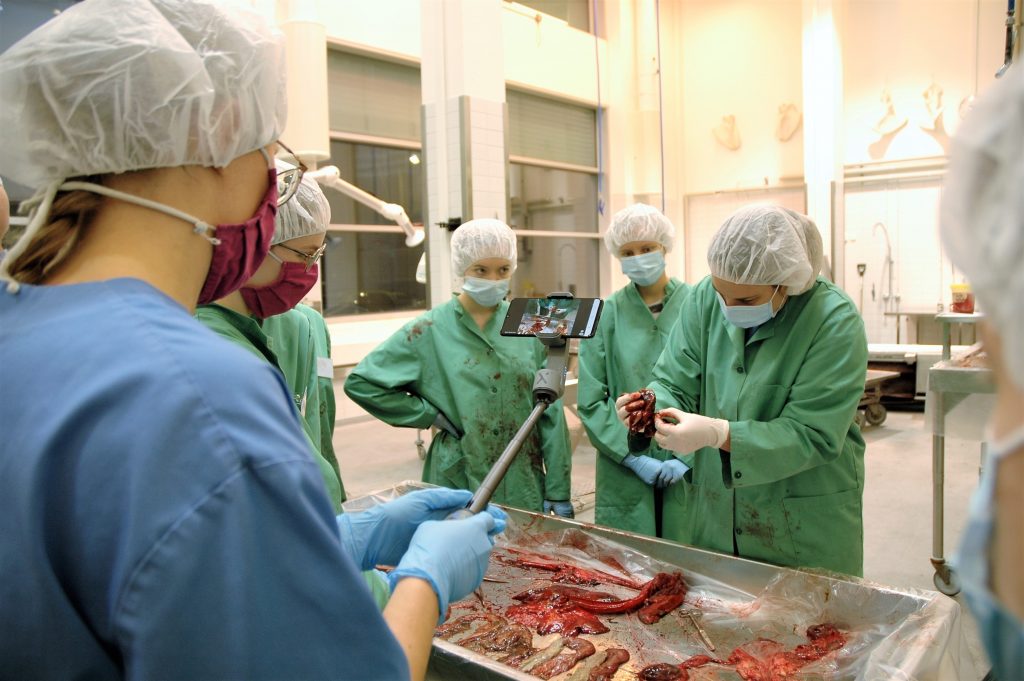
By employing the camera of a smartphone, autopsy findings can be used to benefit a larger group of students, while group sizes in the autopsy room can be organised in accordance with the pandemic-related safety guidelines. (Photo by Satu Leppänen)
University Lecturer in Parasitology, Docent Anu Näreaho returned to the University from a leave of absence to continue her teaching, supervision and research duties, which had been covered by Docent Antti Lavikainen in her absence. In the discipline of parasitology, doctoral students Sanna Malkamäki, LVM, and Katja Hautala, LVM, progressed in their studies as expected over the year.
The discipline hosts a research group led by Docent Sari Tojkander, funded by the Academy of Finland. The group’s research focuses on the mechanobiological regulation of the epithelial tissue of the mammary gland and its relevance to the development of cancer. In addition to Sari, key researchers in the project are Kaisa Rajakylä, PhD, and Anna Acheva, PhD, while veterinarian Vivi Deckwirth, LVM, MA, works as a doctoral student in the group.
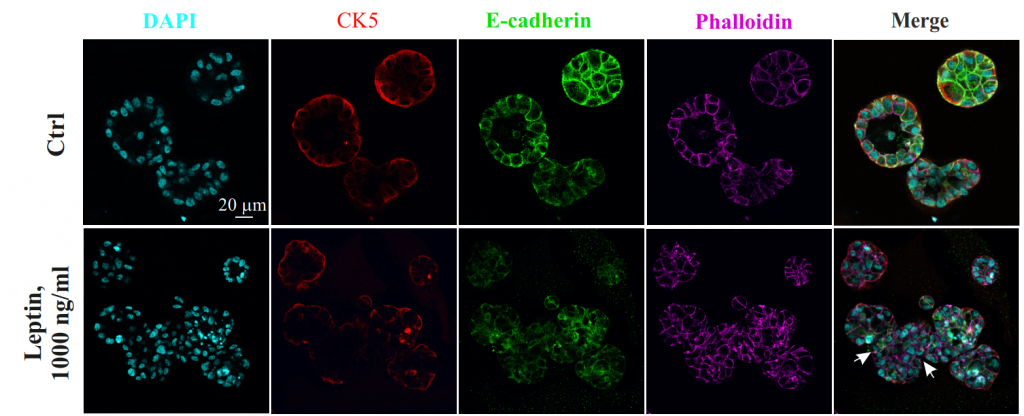
Epithelial mammary gland cells of the MCF10A line in a 3D culture. Leptine produced by adipose stromal cells induces the morphological modification of three-dimensional epithelial structures and increases the cells’ migratory traits. (Images by Anna Acheva)
The efforts of the discipline to support the University and external researchers in matters related to pathology expertise continued, as the Finnish Centre for Laboratory Animal Pathology (FCLAP) received additional HiLIFE infrastructure funding. Jere Lindén, DVM, serves as a research coordinator at FCLAP and is responsible for its operations and those of the histology laboratory.
Veterinary pathologist Paola Amarilla, PhD, DVM, provided an international addition to the staff of the discipline in her role a visiting scholar at the Faculty.
From among the discipline staff, Anu Näreaho and Sanna Malkamäki were particularly central to the development of the Faculty’s ‘Konttorikoira’ (‘Office Dog’) occupational wellbeing project, which received authorisation at the end of the year to initiate a six-month trial. As of the beginning of 2021, some furry wellbeing promoters wearing vests have already been seen on the premises, when telecommuting guidelines have permitted it.
The discipline fared well in its education and diagnostics efforts this year, despite the coronavirus pandemic. At the same time, its publishing activities were successfully maintained even in the exceptional circumstances, while research efforts also progressed. This was made possible by the resilience of the staff and students, as well as their strong commitment to the University’s goals.

A permit was granted late in the year to launch an office dog trial in Building EE. Lilli, a happy and healthy promoter of wellbeing, and Niina Airas, whose stress is being alleviated at work. (Photo by Satu Leppänen)
Tomi Taira
Eläinlääketieteellistne biotieteiden osaston johtaja
Eläinlääketieteellinen tiedekunta
Helsingin yliopisto

